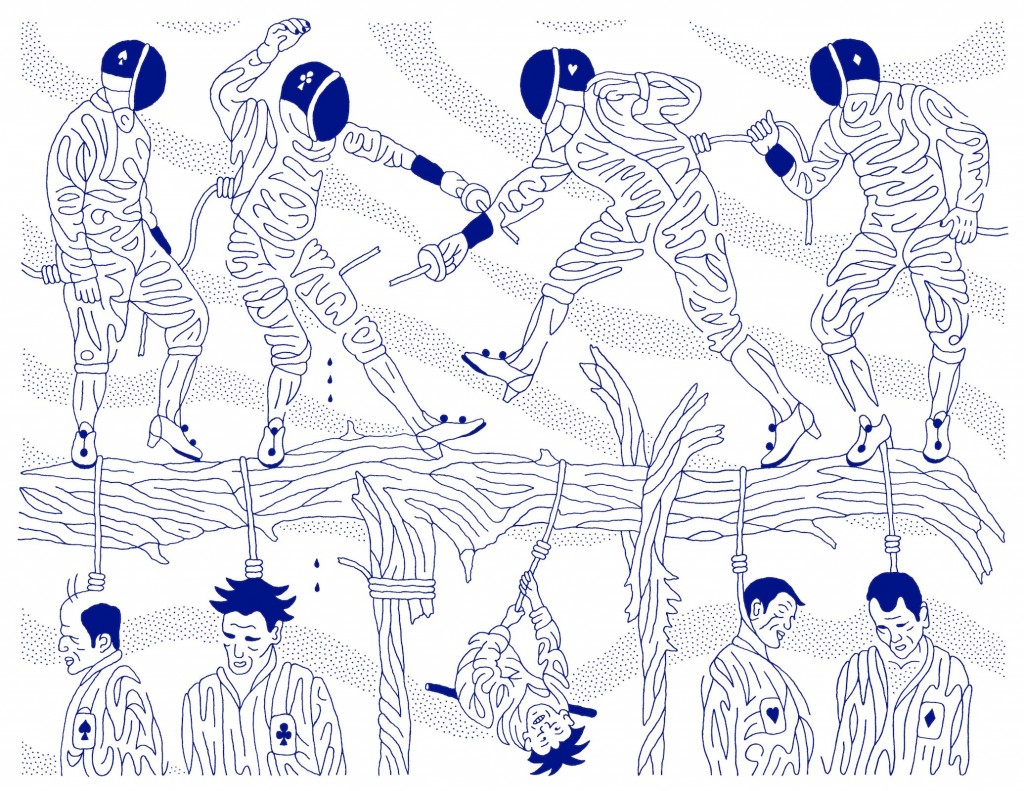John Barth, in his famous essay “The Literature of Exhaustion” (1967), tells us that for artists of all kinds “to be technically out of date is likely to be a genuine defect.” At the time of his writing, the urgent question put to himself and his peers, as Barth understood it, was not how to follow Kafka and Joyce, the most technically up to date writers of the early twentieth century, “but how to succeed those who succeeded Kafka and Joyce.” By Barth’s lights, Nabokov, Beckett, and Borges had done the most to keep the modes of fiction in touch with the middle decades of the century, but even in the mid-1960s, as those master innovators had reached the twilight of their careers, “a good many current novelists write turn-of-the-(20th-) century novels, only in more or less twentieth century language and about contemporary people and topics.”
Kafka, Joyce, Beckett, Nabokov, Borges, John Barth and (good lord!) metafiction—I have the feeling that maybe this may not be the most auspicious opening for a guest post at S[r], a lively online journal not without its exciting examples of literary innovation, and certainly not without a long roster of writers I admire, but nonetheless a publisher of a great many poems, essays, and short stories (including my own) that Barth would surely have recognized as technically out of date. And what’s wrong with that? Beauty can be reached by way of many avenues, some of them comfortably timeworn. We don’t all have to be, as my students sometimes groan (in the very classrooms where Barth once lectured), so “esoteric” and “elitist” and “academic” as Barth.
But Barth’s question is not an academic one. Moreover, it’s one I think we all ought to wrestle with, continually, regardless of our individual aesthetic inclinations. In the end, Barth’s is a question of how writers engage, or choose not to engage, with the world they live in.
When the Barth of “Exhaustion” looked out his window, he saw a world in near-apocalyptic upheaval. President Kennedy had been murdered, The Cold War was raging, the Vietnam War was quickly escalating, Barry Goldwater and the John Birch Society were promoting the use of atomic bombs in Asia, the Civil Rights Movement was meeting violent resistance, and looming over every crisis was the relatively new fact that hostile superpowers had amassed nuclear weapons in numbers capable of destroying civilization many times over. Meanwhile, Madison Avenue advertisers had honed their ability to create persuasive alternate realities free from the anxieties of history.
Barth describes the ethos in terms of “ultimacies—in everything from weaponry to theology” and wonders how out-of-date techniques could manage the task of making art of a world on the verge of extinction. The current conditions required new techniques that acknowledged and made use of what the 19th century could not have imagined. Most of “The Literature of Exhaustion” is dedicated to delineating and praising the artistry of ultimacy in Beckett and, especially, Borges, whose stories tend to begin after everything has already been written and proceed to comment in the form of literary criticism—a literature of the end of things if ever there was one.
Barth the writer of fiction took his greatest, most profitable lessons from Borges. In “Exhaustion,” he praises Borges for his metafictions that “disturb us metaphysically” because “[w]hen characters in a work of fiction become readers or authors of the fiction they’re in, we’re reminded of the fictitious aspect of our own existence.” This description of Borges’s stories serves as an equally apt description of Barth’s own Lost in the Funhouse, which features the famous cut out-able Mobius strip that reads ONCE UPON A TIME THERE on one side and WAS A STORY THAT BEGAN on the other, so that regardless of the techniques Barth employs story by story, the metaphysically disturbing fictive aspect of existence stands always and vividly in the foreground.
Consider the fictitious aspect of our national life as Barth worked on Lost in the Funhouse. Seen in its light, could there be a set of more up-to-date techniques than those displayed in Funhouse? Nearly every story is an imitation of a story which is itself, if you believe Aristotle, as Barth does, an imitation of human action, and this at a time when human action, on both the consumer and political levels anyway, were imitations of fictions.
So I beg the question: who are the technically up-to-date writers of our time? What techniques are so of our time that they speak to and for the world we share?
First and foremost, what should our criteria be?
Our criteria would, of course, have to begin with a sense of the current condition of the world, and it’s seems that the current state of affairs shares a good deal with the world Barth saw. Substitute Iraq for Vietnam, for example, and we once again see geopolitics and many, many actual lives being frankly determined by the fictions of state. That said, one of the most significant distinctions between American life in the first and second decades of the 21st century and that of Barth’s 1960s is that we, like those who trusted the Mayan sages and their apocalyptic calendar, have lived through more than our share of doomsday predictions, enough that they no longer make us jumpy. Most of our population has been fully informed of the once-terrifying nuclear threats since childhood. Even the very real possibility of midtown dirty bombs doesn’t keep us awake at night. For that matter, seeing as we may witness ice-free Arctic summers within a decade, there’s an equally strong chance that we’ll see our species wiped out a lot less suddenly than our parents’ once expected, but even in that case there are no NO NUKES-styled marches or star-studded rock concerts in favor of cap-and-trade. We seem content to roll our eyes at Fox News’ line-up of global warming deniers the same I way I never tire of the story of my former landlord, a third grade teacher in Brooklyn who was stockpiling guns and ammo (I kid you not) with which to combat Bill Clinton’s Y2K conspiracy to takeover the country (yes, the country he was already president of).
So by themselves, the techniques of ultimacy won’t do. Our technique must also express our boredom of threats of ultimacy. Regardless, to whatever degree we’re interested in charting a path forward, we would do well to look back at the best examples of 1960s-styled metafiction. They almost necessarily provide the building blocks for whatever the currently up-to-date will invent.
I say this primarily for reasons “Exhaustion” does not address, namely that Barth’s metafiction represents an inflection point in the development of the most radical, most modern, most self-aware set of techniques yet invented, those of the English Romantics. And almost everything we (especially those of us in the creative writing industry, leading or attending workshops, etc.) call postmodern or experimental has deep roots in the techniques of Romanticism. It was Coleridge and Wordsworth who first understood that the concurrent rising tides of democracy and consumer capitalism robbed European and American culture of a single received Christian teleology and left in its place as many teleologies as there are individual people, each with a consciousness that continually mediates experience by, among other things, comparing it to received stories or narratives of social convention, just as Ambrose in “Lost in the Funhouse” cannot fully participate in his first erotic experience, distracted as he is by the recognition that he’s having an “erotic” experience.
The result is that our once reliable metaphysics was disturbingly de destabilized, just as Barth describes. We became both the readers of the fiction of our lives, recognizing which juncture of the plot we’ve reached and how we can expect to proceed, and the writers of them, in that we are in a continual process of producing and consuming our own self-image. It’s important, I think, to understand that this insight about our being the characters, readers, and authors of our own lives does not originate with Borges or, for that matter, the 20th century, and that the techniques required to make art of the modern condition do wait for the 20th century to find employment. Lord Byron, especially, and John Keats interrupted their own compositions to comment upon the characters and action and language, i.e., the making of the very work we’re reading, as we’re reading, and thereby shattering the fictional dream most of us work terribly hard to keep undisturbed. When referring to 18th and 19th century authorial intrusions, we speak of “romantic irony.” Dr. Anne Mellor, who is brilliant on the matter, describes it thus: “Romantic irony grew out of philosophical skepticism and the social turbulence of the French Revolution and American War of Independence; it posits a universe founded in chaos and incomprehensibility rather than in a divinely ordered teleology.” But one could also say that the point is to “disturb us metaphysically” because when the author becomes a reader of and a character within the fiction they’re composing, we’re reminded of the fictitious aspect of our existence.
What’s disturbing about this reminder is that it calls into question our authenticity as selves. Calling the self into question is largely what Wordsworth’s Prelude is about—a long, never finished, continually revised introduction to the wholesale revelation of self Wordsworth had intended to write but could never properly begin because the introduction could never be completed. Autobiography can never be started, because each possible starting point is so ramified, and the self is so bottomless and unknowable, that only the haze of unknowability can be fixed to the page—such is the Romantic epistemology of self. To transmit to us the feeling of a unknowability, indeed the constant erosion of presumed knowledge, the Prelude gives us sentences so long and so complex that we often lose our way in the middle of them, forgetting where we started.
Keats may give us a different set of techniques, but they bring us to the same end, most obviously and powerfully in “Ode on a Grecian Urn” and its ditties of no tune.
I could go on—and on. But for your sake I’ll point in the direction of just one more pertinent example. Nathaniel Hawthorne, along with Edgar Allan Poe, was Borges’ favorite writer. In fact, and just to complete the circle, Borges tells us that Hawthorne prefigured Kafka, who John Barth sees as Borges’ precursor before choosing to build on Borges’ Hawthorne- and Kafka-infused techniques, the most up-to-date techniques, still, in the late 1960s.
Borges’ favorite Hawthorne story is “Wakefield,” about which he writes very beautifully and very persuasively, so I’ll limit my notes here to a different story, “Young Goodman Brown.”
As the story opens, Goodman Brown is leaving his wife to set off into the woods, not because he is motivated by some personal need or sense of mission but because “tonight of all nights” he must. Brown appears to be a character in a Medieval parable, less a person than human shape plugged into an archetypal plot whose operations will bring us to some Christian lesson, and for the most part, the story’s proceedings are consistent with this expectation. In the woods, Brown meets a man who seems to be or represent the Devil himself, and the woods and its environs take on familiar symbolic dimensions. Further, the Devil figure’s walking stick, when dropped to the forest floor, transforms into a writhing snake.
Or does it?
The apparent parable is regularly punctured by the intrusion of an authorial voice that disturbs the apparently clear and stable metaphysics of “Young Goodman Brown’s” world. In the case of the staff-turned-snake, the authorial voice adds the possibility that what Brown is witnessing is nothing more than an “ocular illusion.” We’re invited to think that maybe what we’re reading isn’t in fact the case. Maybe there’s something less parabolic and more psychological, less archetypal and more characterological, taking place, and we adjust our reading accordingly, aligning ourselves to the story’s foundation of doubt. Maybe, despite Brown and despite the intrusive authorial voice, we’re still operating within a Christian metaphysics, or maybe, despite the parabolic structure and archetypal trappings, we’re encountering a highly defined subjectivity. Either way, we can’t be sure, and the uncertainty, just as Barth suggests, is highly disturbing. We read on in hopes of a conclusive ending, but what we find is that the opposed possibilities remain intact: Brown might have in fact experienced things just as the story describes them, or the events of the story were merely dreamed, in which case we’ve been reading the operations of Brown’s subconscious, that is, the greatest depths of his subjectivity.
All we can say with confidence is that we and Brown are both forever changed. The nature of the change is upsettingly modern: appearances deceive; people maybe or may not be what they seem; there may or may not be a God and a Devil; our experiences may be the product of divine order or, just as easily, the manifestations of indifferent natural forces. If we wish, we can choose one explanation at the expense of the other, but either way we’re supplying cause and effect where none may exists, which is to say we’re creating fictions with the power to shape our lives.
What I hope to have done is trace a reasonably straight line from the radical revolt signaled by Romanticism to some of the fullest expressions of postmodernism. The point of such a line is to suggest that despite the insistence of the creative writing industry—founded by people who rejected the modernism in flourishing upheaval all around them in favor of a far more stable and rational poetics—we have lived for more than 200 years amidst a radical, thoroughly modern, and not yet fully acknowledged literary tradition, one that, even in its 1790s incarnation, is more technically up-to-date than most of us are. This is worth some thought, even if we choose, as most of us will, not to embrace these techniques completely or ever to strive to be technically up-to-date. The worst that can happen is that we affirm our out-of-date, perhaps even nostalgic inclinations, and that affirmation will help us become both more fully ourselves and more aware of our art’s relationship to the world.
Feel free to check out my related essay in World Literature Today.
 Martha Silano is the author of four full-length poetry collections—What the Truth Tastes Like(1999), Blue Positive (2006), The Little Office of the Immaculate Conception (winner of the 2010 Saturnalia Books Poetry Prize and a Washington State Book Award finalist), and Reckless Lovely (2014), also from Saturnalia Books. Her work has appeared in Paris Review, North American Review, Kenyon Review Online, American Poetry Review, and elsewhere. Martha serves as poetry editor of Crab Creek Review and teaches English at Bellevue College.
Martha Silano is the author of four full-length poetry collections—What the Truth Tastes Like(1999), Blue Positive (2006), The Little Office of the Immaculate Conception (winner of the 2010 Saturnalia Books Poetry Prize and a Washington State Book Award finalist), and Reckless Lovely (2014), also from Saturnalia Books. Her work has appeared in Paris Review, North American Review, Kenyon Review Online, American Poetry Review, and elsewhere. Martha serves as poetry editor of Crab Creek Review and teaches English at Bellevue College.







